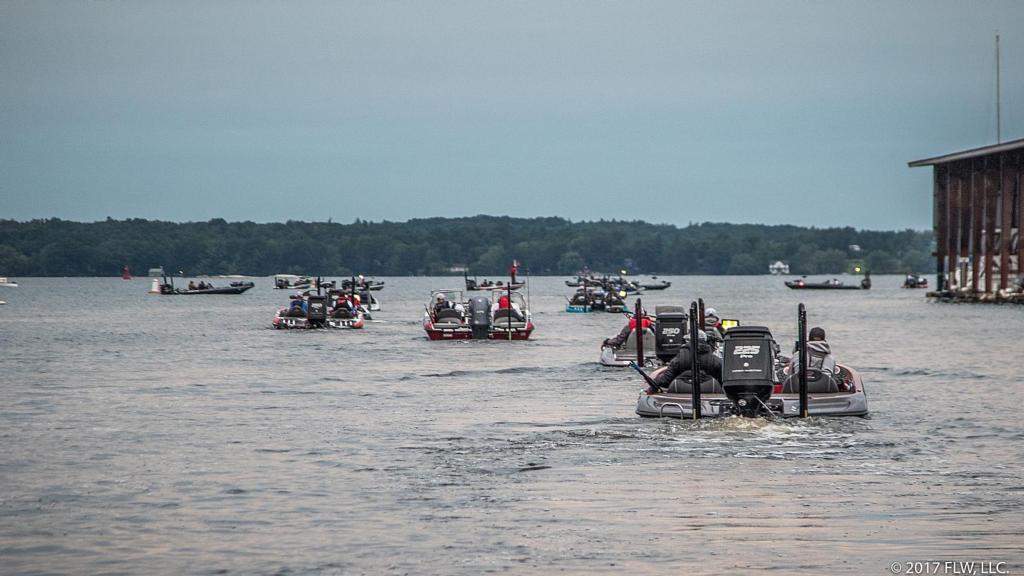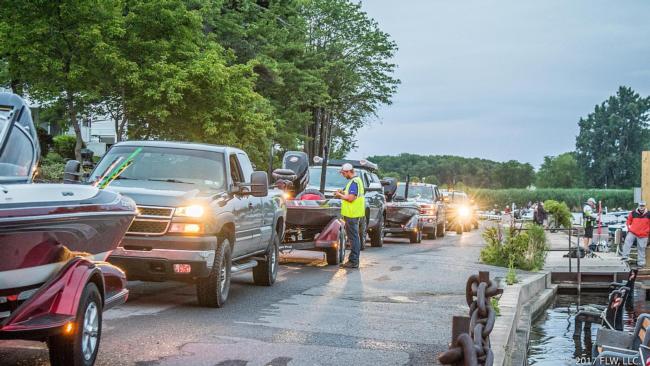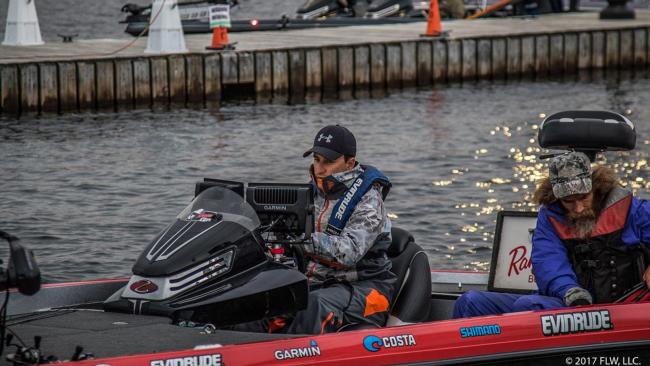River and Lake in Play at 1000 Islands
Bad weather on day one makes the morning decision between the St. Lawrence and Lake Ontario harder for 179 pros

Most will tell you that the fishing in the 1000 Islands area isn’t as easy as it was five or 10 years ago, but it’s still fantastic. We’ll see exactly what it’s capable of producing at stop No. 2 of the Costa FLW Series Northern Division event presented by Evinrude, which begins today. The tournament should feature some amazing smallmouth fishing, both in Lake Ontario and the St. Lawrence River, which comprise the 1000 Islands fishery.
About the fishery
The 1000 Islands area is part of the upper stretch of the St. Lawrence River where more than 1,800 islands sprawl between the U.S. and Canada. The river is known for its deep humps and bars that hold big schools of smallies, but it has them shallow on sand and rock flats as well. Lake Ontario supports populations of brown ones up shallow and on offshore structure, often miles from the bank with nothing but water visible on two or three sides.
The majority of the habitat consists of rock and sand, though there is a decent population of largemouths that inhabit shallow grass in the bays and creeks in the river.
Current conditions
The weather this week has been far from ideal for chasing big-water smallmouths, and it’s going to be far from perfect for competition as well. The preferred conditions for smallmouths on the Great Lakes are sunny with light winds. Storms and a strong southwest wind nearing 20 mph are currently forecast for Thursday morning, with clearing weather and a brisk northeast wind on tap for the final two days of competition.
Though an east wind is fine in the lake, it is usually bad news in the river. There, it causes the waves to stack up and makes presenting the bait properly with the current a major challenge. On the lake, any wind remotely out of the west has the full length of the 13th largest lake in the world to build waves with.
As for the actual water, the lake and the river are both higher than usual. The water color in the river is about normal, but the current is running stronger than normal, which most pros think is a good thing. Water temperatures are in the high 60s and low 70s, and the vast majority of the fish have finished spawning.
Tactics in play
There are always shallow fish to be caught in the 1000 Islands region, and the deep bite really dominates later in August and September. Nonetheless, there’s plenty of debate as to how exactly this event will be won. In fact, there’s a good chance the winner could weigh fish caught from just a few feet of water and as deep as 30 feet of water.
For both deep and shallow fish, a drop-shot with a goby or minnow-style bait will be a critical tool. For the shallower fish, swimbaits, jerkbaits, spybaits and even spinnerbaits will come into play.
The river has some excellent largemouth fishing, and while it rarely has the juice for a win, good bags are available. Frogs and soft plastics are go-to options for largemouths.
Critical factors
- The wind – Wind direction influences the current and how the fish bite, both in the river and the lake. Even more importantly, the waves can dramatically impact run times in the river and especially on Lake Ontario.
- The weather – Almost every pro in the event who wants to fish shallow wants sun. Smallmouths bite better with it, and its presence or lack thereof will be a major factor in some game plans and perhaps the outcome.
Dock talk
With 179 boats signed up, the 1000 Islands will be busy, but everyone predicts the fishing to be good despite plenty of anglers and iffy weather. Across the board, the pros we surveyed at registration think that it’ll take a weight in the mid- to upper 60s to win, and expect to see a bevy of 6-pound smallmouths hit the scale.
The big decision for many is going to be whether to run into the lake or stick in the river on day one.
“Saturday was relatively calm,” says 2016 1000 Islands champion Scott Dobson of his practice. “You could get around and the sun was out, and that was my best day. That was in the lake, and I think there are a lot of fish to be had in the lake. I’d love to get out in the lake Thursday, but that might not be in the cards.”
Dobson says a lot of the areas he fished in 2016 looked good again in practice, and he spent days two and three in the river last year. So, he’s probably got pretty good back-up stuff if need be.
“I’m going to the lake,” says a determined Casey Smith, who has practiced the eastern end of Ontario hard the last two weeks. “The river threw me for a surprise with what it did last week [for the Bassmaster Elite Series event], with just how good it was. Coming in I thought lake, lake, lake, and then that threw me off a little bit.”
With fish in all stages, Smith thinks that the winner is likely to sample both shallow and deep.
“I think Dobson won last year shallow, and I think the weather is going to prohibit that,” he says. “But the weather is also going to make it very difficult to win deep in the river because of that east wind. You can win deep, but it’s going to be an [Bob] Izumi or a [Chris or Cory] Johnston – someone who has tons and tons of deep holes to run.”
Chris and Cory Johnston are definite favorites this week, and both finished inside the top five in last year’s 1000 Island showdown.
“I’m going to fish both the river and the lake, and this is the first time I’ve really ever put the river into my game plan. There’s big ones to be had in it,” says Cory, who is planning on riding out the storms near Clayton, the takeoff site. “I’m going to try and stick in the river in the morning, and then I’ve got back-up stuff out in the lake. I’m going to be mostly deep. The weather is just not conducive to catch big shallow-water smallmouths in numbers.”
Tournament details
Format: All boaters and co-anglers will compete for two days. The top 10 boaters and co-anglers based on cumulative weight after two days of competition will advance to the third and final round, with the winner in each division determined by the heaviest cumulative three-day weight.
Takeoff Time: 6:30 a.m. ET
Takeoff Location: Clayton Village Ramp, 750 Mary Street, Clayton, N.Y.
Weigh-In Time: 2:30 p.m. ET
Weigh-In Location: Clayton Village Ramp

